
Ecsenius is a large genus of fish in the family Blenniidae. Several species, including Ecsenius midas, the Midas blenny, and Ecsenius bicolor, the bicolor blenny, are commonly sold at aquarium stores as pets.
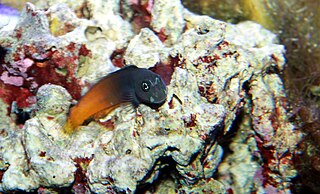
Ecsenius bicolor, commonly known as the flame tail blenny or bicolor blenny, is a blenny from the Indo-Pacific. It frequently makes its way into the aquarium trade. It grows to a size of 11 centimetres (4.3 in) in length.
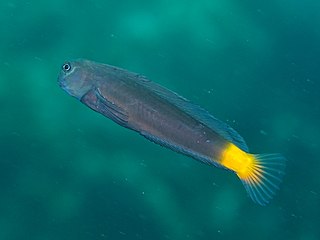
Ecsenius namiyei, commonly called black comb-tooth blenny or Namiye's coralblenny, is a species of marine fish in the family Blenniidae. The specific name honours the Japanese zoologist and museum curator Motoyoshi Namiye (1854-1915).
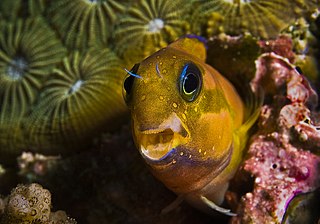
Ecsenius midas, known commonly as the Midas blenny, Persian blenny, lyretail blenny or golden blenny, is a species of marine fish in the family Blenniidae.

Ecsenius bimaculatus, known commonly as the twinspot coralblenny, is a species of marine fish in the family Blenniidae.

The Australian blenny is a small marine blennioid fish of the genus Ecsenius. They are small and reddish brown with a white ventral side. Australian blennies inhabit the shallow marine waters of the tropics. They are often found along the Great Barrier Reef and Coral Sea of Australia.
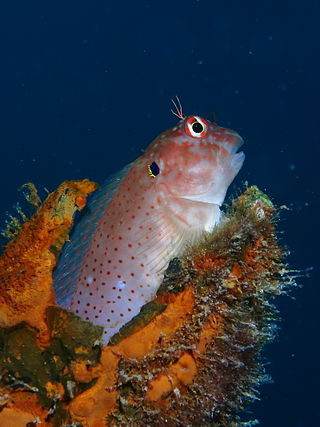
Cirripectes auritus, the blackflap blenny, is a species of combtooth blenny found in coral reefs in the Indo-West Pacific region.

Cirripectes polyzona, the barred blenny, is a species of combtooth blenny found in coral reefs in the Indo-West pacific region. This species reaches a length of 13 centimetres (5.1 in) TL.
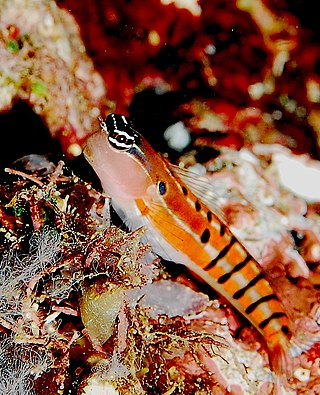
Ecsenius axelrodi, known commonly as the Axelrod's clown blenny or the Axelrod's combtooth blenny, is a species of ray-finned fish in the family Blenniidae, the combtooth blennies. It is found in shallow water on coral reefs in the western central Pacific Ocean. It was first described by Victor Gruschka Springer in 1988 and named in honour of the American ichthyologist Herbert Richard Axelrod.
Ecsenius caeruliventris, known commonly as the bluebelly blenny in Indonesia, is a species of combtooth blenny in the genus Ecsenius. It is a tropical blenny found in the western Pacific ocean, specifically in Sulawesi, Indonesia. Male Ecsenius caeruliventris can reach a maximum length of 2.4 centimetres, while females can reach a maximum length of 2.37 centimetres; it is one of the smallest blennies in Ecsenius. The species name means "sky-blue belly" from the Latin words caeruleus and ventris, referring to the blue abdomen on the species; the common name is derived from this. The species is most similar to its sister taxon E. shirleyae and E. bandanus.

Ecsenius alleni, known commonly as the Allen's blenny, is a species of combtooth blenny in the genus Ecsenius. It is found in coral reefs in the eastern Indian Ocean, specifically in western Australia. It can reach a maximum length of 3.4 centimetres. The blennies feed primarily off of plants and algae. The specific name honours the ichthyologist Gerald R. Allen.
Ecsenius collettei, known commonly as the Collete's blenny in Papua New Guinea, is a species of combtooth blenny in the genus Ecsenius. It is found in coral reefs in the western central Pacific ocean, specifically in Papua New Guinea. It can reach a maximum length of 5 centimetres. The blennies feed primarily off of plants, and benthic algae and weeds. he specific name honours Bruce B. Collette the Director of the National Marine Fisheries Service Systematics Laboratory, whose collection of fish specimens from New Guinea contained a number important blenniid specimens, one of which was this species.
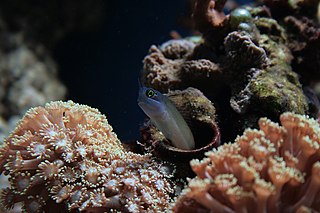
Ecsenius melarchus, known commonly as the yellow-eyed comb-tooth or the Java combtooth-blenny in Indonesia, is a species of combtooth blenny in the genus Ecsenius. It is found in coral reefs in the western Pacific ocean. It can reach a maximum length of 5 centimetres. Blennies in this species primarily feed off of plants, including benthic algae and weeds, and are commercial aquarium fish. The specific name "melarchus" is Latin for "black anus", and refers to the black anal marking on the blennies in this species.

Ecsenius pictus, known commonly as the white-lined comb-tooth in Indonesia and the pictus blenny in Micronesia, is a species of combtooth blenny family Blenniidae.
Ecsenius lubbocki, the Lubbock's combtooth-blenny, is a species of combtooth blenny in the genus Ecsenius. It is found in coral reefs in Phuket, Thailand, in the eastern Indian Ocean. It can reach a maximum length of 4 centimetres. Blennies in this species feed primarily off of plants, including benthic algae and weeds. The specific name honours the English marine biologist Hugh Roger Lubbock (1951–1981), the collector of the type specimens, he recognised that they were a new species of Ecsenius.

Ecsenius mandibularis, also known as the many-toothed blenny, Queensland combtooth blenny or Queensland blenny in Australia, is a species of combtooth blenny in the genus Ecsenius. It is found in coral reefs in the western Pacific ocean, including the southern edge of the Great Barrier Reef. It can reach a maximum length of 7.5 centimetres. Blennies in this species feed primarily off of plants, including benthic algae and weeds.
Ecsenius oculus, known commonly in Micronesia as the ocular blenny and as the coral blenny on Christmas Island, is a species of combtooth blenny in the genus Ecsenius. It is found in coral reefs in the western Pacific ocean. It can reach a maximum length of 7 centimetres. Blennies in this species feed primarily off of plants, including benthic algae and weeds, and are commercial aquarium fish.
Ecsenius ops, known commonly as the eye-spot blenny or the yellow-eye combtooth-blenny in Indonesia, is a species of combtooth blenny the family Blenniidae.
Ecsenius tigris, known commonly as the tiger blenny in Australia, is a species of combtooth blenny in the genus Ecsenius. It is found in the western Pacific ocean, specifically the western Coral Sea. It can reach a maximum length of 5 centimetres. Blennies in this species feed primarily off of plants, including benthic algae and weeds, and are commercial aquarium fish.

Ecsenius yaeyamaensis, known commonly as the Yaeyama blenny in Guam and Micronesia, and also known as the Yaeyama clown blenny in Micronesia, or the Pale-spotted combtooth-blenny in Indonesia is a species of combtooth blenny in the genus Ecsenius. It is found in coral reefs in the western Pacific and Indian oceans. It can reach a maximum length of 6 centimetres. Blennies in this species feed primarily off of plants, including benthic algae and weeds, and are commercial aquarium fish.














